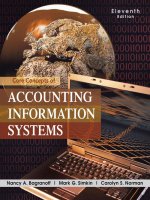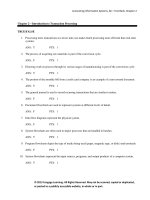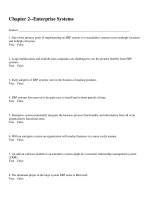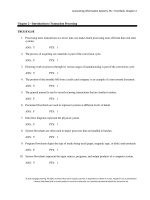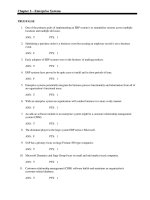Accounting information systems ch01
Bạn đang xem bản rút gọn của tài liệu. Xem và tải ngay bản đầy đủ của tài liệu tại đây (1.04 MB, 34 trang )
Introduction to
Accounting
Information
Systems
•
•
•
•
•
•
•
•
•
•
Learning Objectives
To appreciate the complex, dynamic
environment in which accounting is practiced.
To know the AIS, its relationship to the
organizations business processes
To know the attributes of information
To understand decision making
Recognize how information is used a various
organizational levels
Recognize how information supports
management functions
Appreciate the influence of strategic planning
on success
Understand the importance of the IS strategic
plan
To recognize the accountant’s role in relation
to the current environment for AIS.
To understand how to use this textbook
effectively to learn AIS.
Introduction
to Accounting
Information
Systems
The AIS Wheel
• Introduces each
chapter; topics are
listed on spokes,
hub and perimeter of
wheel
3
Textbook Themes
1.
2.
3.
Enterprise systems— integrate the business
process functionality and information from all of an
organization’s functional areas, such as marketing
and sales, cash receipts, purchasing, cash
disbursements, human resources, production and
logistics, and business reporting (including financial
reporting).
E-Business—use of networks to undertake
business processes
Internal control— a system of integrated elements
that provide reasonable assurance that a business
will reach its business process goals
4
Elements in the Study of AIS
5
Accounting
System
and Subsystems
6
Accounting Systems and
Subsystems
• A system is a set of interdependent
elements that together accomplish
specific objectives.
• A subsystem is the interrelated parts
that have come together, or integrated,
as a single system, which we have
named System 1.0.
7
Information System Model
• An information system (IS) (or management
information system [MIS]) is a manmade
system that generally consists of an integrated
set of computer-based and manual components
established to collect, store, and manage data
and to provide output information to users.
• The Figure on the next slide depicts the
functional components of an information system.
8
Information System Model
9
Purpose of AIS
• Collect, process and report information
related to the financial aspects of
business events
• Often integrated and indistinguishable
from overall information system
• Like the IS, the AIS may be divided into
components based on the operational
functions supported.
10
Comparison of Manual and
Automated Systems
11
Components of Business Process
1. Management hires
personnel and
establishes the
means for
accomplishing
the work of the
organization.
12
Components of Business Process
2. Management
establishes broad
marketing objectives
and assigns sales
quotas to measure
progress toward the
long-run objectives.
Management also
designs the IS
procedures for
facilitating
operations, such as
the procedures used
to pick and ship
goods to the
customer.
13
Components of Business Process
3. The IS receives
the customer’s
purchase order.
14
Components of Business Process
4. The IS
acknowledges the
customer’s purchase
order (send order
acknowledgement).
15
Components of Business Process
5. The IS sends a
request to ship
goods to warehouse.
This request
identifies the goods
and their location in
the warehouse.
16
Components of Business Process
6. A document (i.e., a
packing slip)
identifying the
customer and the
goods is attached to
the goods.
17
Components of Business Process
7. Goods are
shipped to customer.
18
Components of Business Process
8. The shipping
department reports
to the IS that the
goods have been
shipped.
19
Components of Business Process
9. The IS prepares
an invoice and sends
it to the customer.
20
Components of Business Process
10. The IS sends
management a
report comparing
actual sales to
previously
established sales
quotas.
21
Information Qualities
22
Management Decision Making
1. Intelligence: Searching the
environment for conditions calling for a
decision.
2. Design: Inventing, developing, and
analyzing possible courses of action.
3. Choice: Selecting a course of action.
23
Management Decision Making
24
flo
ws
fo
rm
at
ion
Ve
rti
ca
l in
Strategic
Management
Tactical
Managemen
t
Operations
Management
Operations and
Transaction Processing
Horizontal information flows
25

